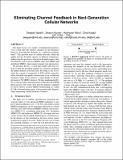Eliminating Channel Feedback in Next-Generation Cellular Networks
Author(s)
Kumar, Swarun; Vasisht, Deepak; Rahul, Hariharan Shankar; Katabi, Dina
DownloadKatabi_Eliminating channel.pdf (703.7Kb)
OPEN_ACCESS_POLICY
Open Access Policy
Creative Commons Attribution-Noncommercial-Share Alike
Terms of use
Metadata
Show full item recordAbstract
This paper focuses on a simple, yet fundamental question: ``Can a node infer the wireless channels on one frequency band by observing the channels on a different frequency band?'' This question arises in cellular networks, where the uplink and the downlink operate on different frequencies. Addressing this question is critical for the deployment of key 5G solutions such as massive MIMO, multi-user MIMO, and distributed MIMO, which require channel state information.
We introduce R2-F2, a system that enables LTE base stations to infer the downlink channels to a client by observing the uplink channels from that client. By doing so, R2-F2 extends the concept of reciprocity to LTE cellular networks, where downlink and uplink transmissions occur on different frequency bands. It also removes a major hurdle for the deployment of 5G MIMO solutions. We have implemented R2-F2 in software radios and integrated it within the LTE OFDM physical layer. Our results show that the channels computed by R2-F2 deliver accurate MIMO beamforming (to within 0.7~dB of beamforming gains with ground truth channels) while eliminating channel feedback overhead.
Date issued
2016-08Department
Massachusetts Institute of Technology. Computer Science and Artificial Intelligence LaboratoryJournal
Proceedings of the 2016 conference on ACM SIGCOMM 2016 Conference - SIGCOMM '16
Publisher
Association for Computing Machinery
Citation
Vasisht, Deepak, et al. "Eliminating Channel Feedback in Next-Generation Cellular Networks." Proceedings of the 2016 ACM SIGCOMM Conference, 22-26 August, 2016, Florianopolis, Brazil, ACM Press, 2016, pp. 398–411.
Version: Author's final manuscript
ISSN
978-1-4503-4193-6